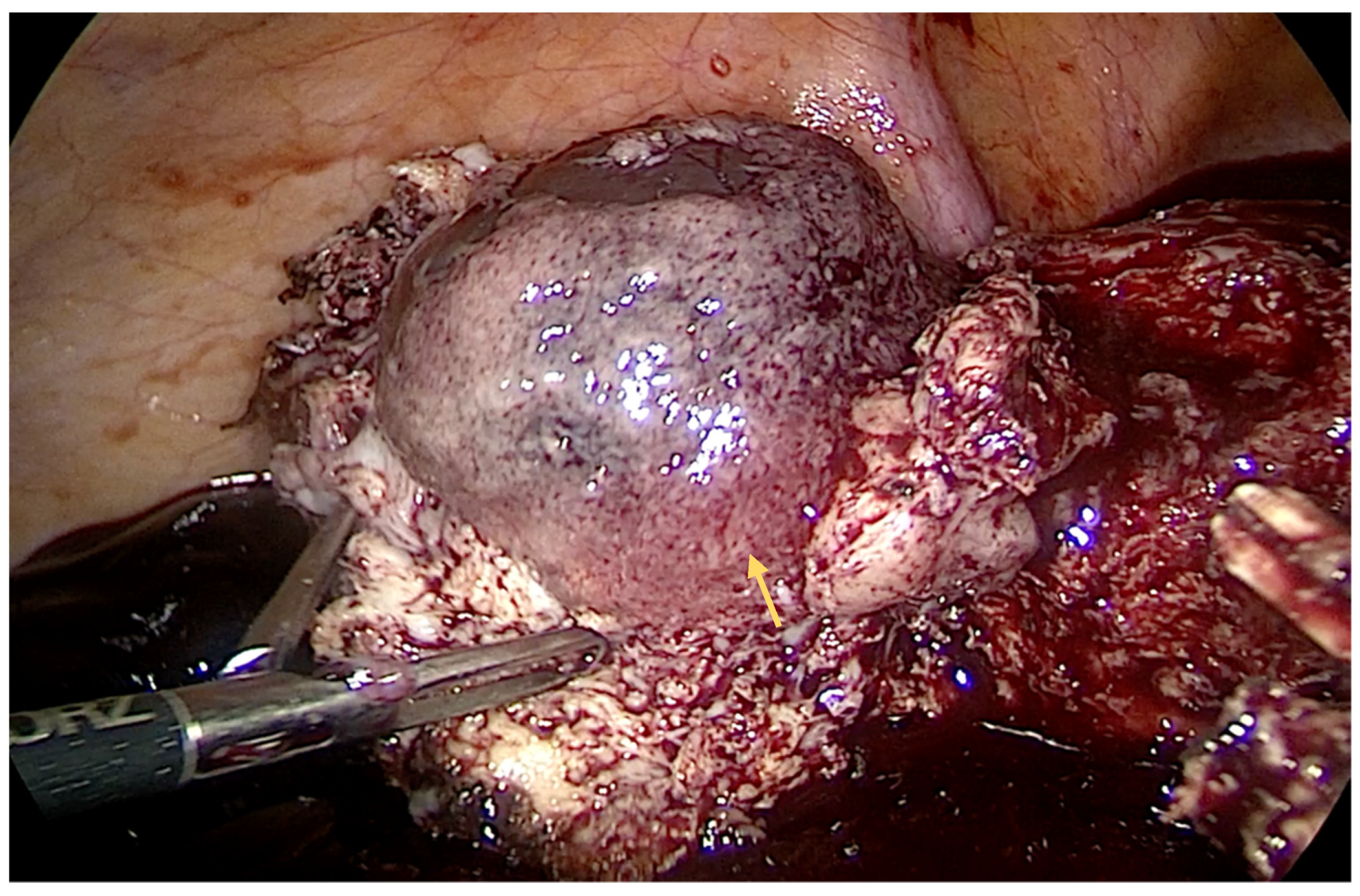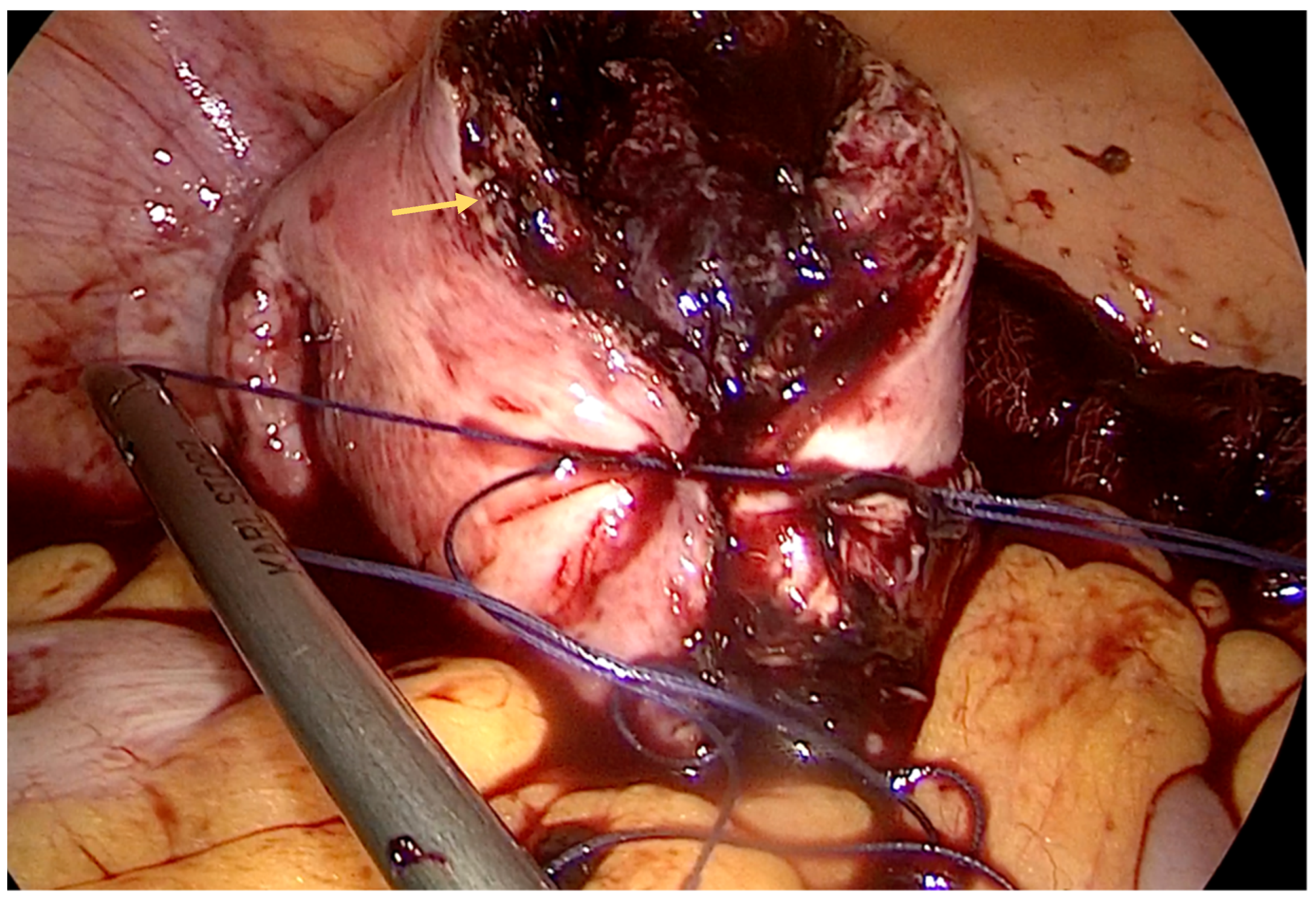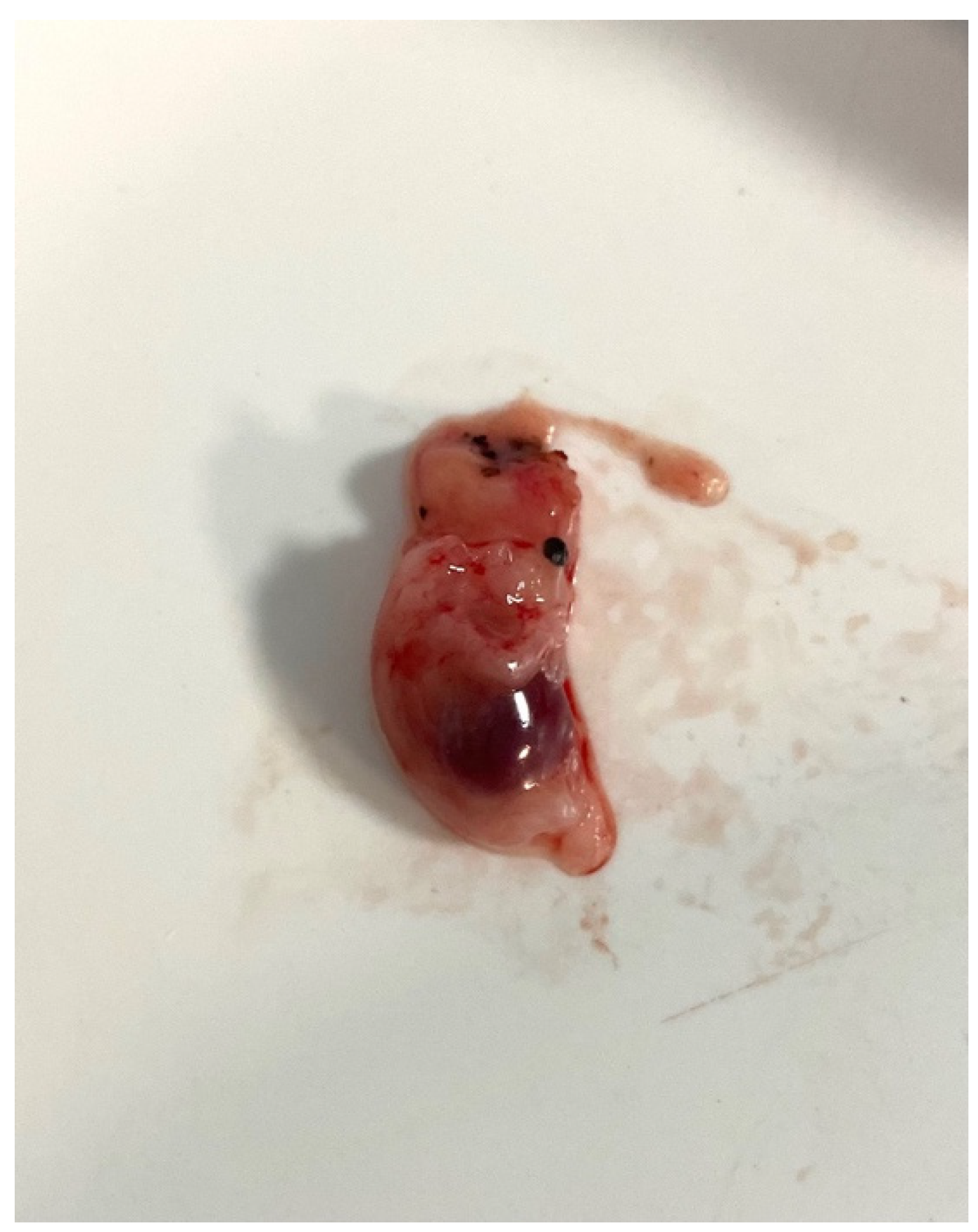Ruptured Recurrent Interstitial Ectopic Pregnancy Successfully Managed by Laparoscopy
Abstract
Author Contributions
Funding
Institutional Review Board Statement
Informed Consent Statement
Data Availability Statement
Conflicts of Interest
Abbreviations
| EP | Ectopic pregnancy |
| IP | Interstitial pregnancy |
| MRI | Magnetic resonance imaging |
| beta-hCG | Beta-human chorionic gonadotropin |
References
- Kalidindi, M.; Shahid, A.; Odejinmi, F. Expect the unexpected: The dilemmas in the diagnosis and management of interstitial ectopic pregnancy—Case report and literature review. Gynecol. Minim. Invasive Ther. 2016, 5, 35–37. [Google Scholar] [CrossRef]
- Rastogi, R.; Meena, G.L.; Rastogi, N.; Rastogi, V. Interstitial ectopic pregnancy: A rare and difficult clinicosonographic diagnosis. J. Hum. Reprod. Sci. 2008, 1, 81–82. [Google Scholar] [CrossRef] [PubMed]
- Corioni, S.; Perelli, F.; Bianchi, C.; Cozzolino, M.; Maggio, L.; Masini, G.; Coccia, M.E. Interstitial pregnancy treated with a single-dose of systemic Methotrexate: A successful management. J. Res. Med. Sci. 2015, 20, 312–316. [Google Scholar] [CrossRef] [PubMed]
- Surekha, S.M.; Chamaraja, T.; Singh, N.; Neeraja, T.S. A ruputured left cornual pregnancy: A case report. J. Clin. Diagn. Res. 2013, 7, 1455–1456. [Google Scholar]
- Tulandi, T.; Al-Jaroudi, D. Interstitial pregnancy: Results generated from the society of reproductive surgeons registry. Obstet. Gynecol. 2004, 103, 47–50. [Google Scholar] [CrossRef]
- Mettler, L.; Sodhi, B.; Schollmeyer, T.; Mangeshikar, P. Ectopic pregnancy treatment by laparoscopy, a short glimpse. Minim. Invasive Ther. Allied Technol. 2006, 15, 305–310. [Google Scholar] [CrossRef] [PubMed]
- Chan, L.Y.-S.; Fok, W.Y.; Yuen, P.M. Pitfalls in diagnosis of interstitial pregnancy. Acta Obstet. Gynecol. Scand. 2003, 82, 867–870. [Google Scholar] [CrossRef] [PubMed]
- Jermy, K.; Thomas, J.; Doo, A.; Bourne, T. The conservative management of interstitial pregnancy. BJOG Int. J. Obstet. Gynaecol. 2004, 111, 1283–1288. [Google Scholar] [CrossRef]
- Moawad, N.S.; Mahajan, S.T.; Moniz, M.H.; Taylor, S.E.; Hurd, W.W. Current diagnosis and treatment of interstitial pregnancy. Am. J. Obstet. Gynecol. 2010, 202, 15–29. [Google Scholar] [CrossRef]
- Brincat, M.; Bryant-Smith, A.; Holland, T.K. The diagnosis and management of interstitial ectopic pregnancies: A review. Gynecol. Surg. 2019, 16, 2. [Google Scholar] [CrossRef]
- Dagar, M.; Srivastava, M.; Ganguli, I.; Bhardwaj, P.; Sharma, N.; Chawla, D. Interstitial and Cornual Ectopic Pregnancy: Con-servative Surgical and Medical Management. J. Obstet. Gynecol. India 2018, 68, 471–476. [Google Scholar] [CrossRef]
- Warda, H.; Mamik, M.M.; Ashraf, M.; Abuzeid, M.I. Interstitial Ectopic Pregnancy: Conservative Surgical Management. JSLS J. Soc. Laparosc. Robot. Surg. 2014, 18, 197–203. [Google Scholar] [CrossRef][Green Version]
- Nezhat, C.H.; Dun, E.C. Laparoscopically-assisted, Hysteroscopic Removal of an Interstitial Pregnancy with a Fertility-Preserving Technique. J. Minim. Invasive Gynecol. 2014, 21, 1091–1094. [Google Scholar] [CrossRef]
- Faraj, R.; Steel, M. Management of cornual (interstitial) pregnancy. Obstet. Gynaecol. 2007, 9, 249–255. [Google Scholar] [CrossRef]
- Grimbizis, G.F.; Tsalikis, T.; Mikos, T.; Zepiridis, L.; Athanasiadis, A.; Tarlatzis, B.C.; Bontis, J.N. Case report: Laparoscopic treatment of a ruptured interstitial pregnancy. Reprod. Biomed. Online 2004, 9, 447–451. [Google Scholar] [CrossRef] [PubMed]
- De Cherney, A.; Diamond, M.; Lavy, G.; Boyers, S. Removal of ectopic pregnancy via the laparoscope. Obstet. Gyncol. 1987, 70, 948. [Google Scholar]
- Slaoui, A.; Slaoui, A.; Zeraidi, N.; Lakhdar, A.; Kharbach, A.; Baydada, A. Interstitial pregnancy is one of the most serious and uncommon ectopic pregnancies: Case report. Int. J. Surg. Case Rep. 2022, 95, 107195. [Google Scholar] [CrossRef] [PubMed]
- Lin, T.-Y.; Chueh, H.-Y.; Chang, S.-D.; Yang, C.-Y. Interstitial ectopic pregnancy: A more confident diagnosis with three-dimensional sonography. Taiwan J. Obstet. Gynecol. 2021, 60, 173–176. [Google Scholar] [CrossRef] [PubMed]
- Gleicher, N.; Karande, V.; Rabin, D.; Pratt, D. Laparoscopic removal of twin cornual pregnancy after in vitro fertilization. Fertil. Steril. 1994, 61, 1161–1162. [Google Scholar] [CrossRef] [PubMed]
- Van der Weiden, R.M.; Karsdorp, V.H.M. Recurrent cornual pregnancy after heterotopic cornual pregnancy successfully treated with systemic methotrexate. Arch. Gynecol. Obstet. 2005, 273, 180–181. [Google Scholar] [CrossRef] [PubMed]
- Erdem, M.; Erdem, A.; Arslan, M.; Öç, A.; Biberoğlu, K.; Gürsoy, R. Single-dose methotrexate for the treatment of unruptured ectopic pregnancy. Arch. Gynecol. Obstet. 2004, 270, 201–204. [Google Scholar] [CrossRef]
- Canis, M.; Savary, D.; Pouly, J.L.; Wattiez, A.; Mage, G. Grossesse extra-utérine: Critères de choix du traitement médical ou du traitement chirurgical [Ectopic pregnancy: Criteria to decide between medical and conservative surgical treatment]. J. Gynecol. Obstet. Biol. Reprod. 2003, 32, S54–S63. [Google Scholar]
- Rana, P.; Kazmi, I.; Singh, R.; Afzal, M.; Al-Abbasi, F.A.; Aseeri, A.; Singh, R.; Khan, R.; Anwar, F. Ectopic pregnancy: A review. Arch. Gynecol. Obstet. 2013, 288, 747–757. [Google Scholar] [CrossRef] [PubMed]
- Po, L.; Thomas, J.; Mills, K.; Zakhari, A.; Tulandi, T.; Shuman, M.; Page, A. Guideline No. 414: Management of Pregnancy of Unknown Location and Tubal and Nontubal Ectopic Pregnancies. J. Obstet. Gynaecol. Can. 2021, 43, 614–630.e1. [Google Scholar] [CrossRef] [PubMed]
- MacRae, R.; Olowu, O.; Rizzuto, M.I.; Odejinmi, F. Diagnosis and laparoscopic management of 11 consecutive cases of cornual ectopic pregnancy. Arch. Gynecol. Obstet. 2009, 280, 59–64. [Google Scholar] [CrossRef] [PubMed]
- Ng, S.; Hamontri, S.; Chua, I.; Chern, B.; Siow, A. Laparoscopic management of 53 cases of cornual ectopic pregnancy. Fertil. Steril. 2009, 92, 448–452. [Google Scholar] [CrossRef] [PubMed]
- Bahall, V.; Cozier, W.; Latchman, P.; Elias, S.-A.; Sankar, S. Interstitial ectopic pregnancy rupture at 17 weeks of gestation: A case report and literature review. Case Rep. Women’s Health 2022, 36, e00464. [Google Scholar] [CrossRef]
- Meyer, W.R.; Decherney, A.H. 8 Laparoscopic treatment of ectopic pregnancy. Baillière’s Clin. Obstet. Gynaecol. 1989, 3, 583–594. [Google Scholar] [CrossRef]
- Schollmeyer, T.; Talab, Y.; Lehmann-Willenbrock, E.; Mettler, L. Experience of laparoscopic tubal surgery at Dept of Obstetrics and Gynaecology, University of Kiel, from 1999 through 2000. J. Soc. Laparoendosc. Surg. 2004, 8, 334–338. [Google Scholar]
- Siow, A.N.; Ng, S. Laparoscopic management of 4 cases of recurrent cornual ectopic pregnancy and review of literature. J. Minim. Invasive Gynecol. 2011, 18, 296–302. [Google Scholar] [CrossRef]
- Soriano, D.; Vicus, D.; Mashiach, R.; Schiff, E.; Seidman, D.; Goldenberg, M. Laparoscopic treatment of cornual pregnancy: A series of 20 consecutive cases. Fertil. Steril. 2008, 90, 839–843. [Google Scholar] [CrossRef]
- Marchand, G.; Masoud, A.T.; Sainz, K.; Azadi, A.; Ware, K.; Vallejo, J.; Anderson, S.; King, A.; Osborn, A.; Ruther, S.; et al. A systematic review and meta-analysis of laparotomy compared with laparoscopic management of interstitial pregnancy. Facts Views Vis. Obgyn. 2021, 12, 299–308. [Google Scholar]
- Tay, J.I.; Moore, J.; Walker, J.J. Ectopic Pregnancy. BMJ 2000, 320, 916–919. [Google Scholar] [CrossRef]
- Juneau, C.; Bates, G.W. Reproductive Outcomes after Medical and Surgical Management of Ectopic Pregnancy. Clin. Obstet. Gynecol. 2012, 55, 455–460. [Google Scholar] [CrossRef] [PubMed]
- Perlman, B.E.; Guerrero, K.; Karsalia, R.; Heller, D.S. Reproductive outcomes following a ruptured ectopic pregnancy. Eur. J. Contracept. Reprod. Health Care 2020, 25, 206–208. [Google Scholar] [CrossRef]
- Job-Spira, N.; Fernandez, H.; Bouyer, J.; Pouly, J.-L.; Germain, E.; Coste, J. Ruptured tubal ectopic pregnancy: Risk factors and reproductive outcome: Results of a population-based study in France. Am. J. Obstet. Gynecol. 1999, 180, 938–944. [Google Scholar] [CrossRef] [PubMed]
- Baggio, S.; Garzon, S.; Russo, A.; Ianniciello, C.Q.; Santi, L.; Laganà, A.S.; Raffaelli, R.; Franchi, M. Fertility and reproductive outcome after tubal ectopic pregnancy: Comparison among methotrexate, surgery and expectant management. Arch. Gynecol. Obstet. 2021, 303, 259–268. [Google Scholar] [CrossRef] [PubMed]





Disclaimer/Publisher’s Note: The statements, opinions and data contained in all publications are solely those of the individual author(s) and contributor(s) and not of MDPI and/or the editor(s). MDPI and/or the editor(s) disclaim responsibility for any injury to people or property resulting from any ideas, methods, instructions or products referred to in the content. |
© 2024 by the authors. Licensee MDPI, Basel, Switzerland. This article is an open access article distributed under the terms and conditions of the Creative Commons Attribution (CC BY) license (https://creativecommons.org/licenses/by/4.0/).
Share and Cite
Ungureanu, C.O.; Stanculea, F.C.; Iordache, N.; Georgescu, T.F.; Ginghina, O.; Mihailov, R.; Vacaroiu, I.A.; Georgescu, D.E. Ruptured Recurrent Interstitial Ectopic Pregnancy Successfully Managed by Laparoscopy. Diagnostics 2024, 14, 506. https://doi.org/10.3390/diagnostics14050506
Ungureanu CO, Stanculea FC, Iordache N, Georgescu TF, Ginghina O, Mihailov R, Vacaroiu IA, Georgescu DE. Ruptured Recurrent Interstitial Ectopic Pregnancy Successfully Managed by Laparoscopy. Diagnostics. 2024; 14(5):506. https://doi.org/10.3390/diagnostics14050506
Chicago/Turabian StyleUngureanu, Claudiu Octavian, Floris Cristian Stanculea, Niculae Iordache, Teodor Florin Georgescu, Octav Ginghina, Raul Mihailov, Ileana Adela Vacaroiu, and Dragos Eugen Georgescu. 2024. "Ruptured Recurrent Interstitial Ectopic Pregnancy Successfully Managed by Laparoscopy" Diagnostics 14, no. 5: 506. https://doi.org/10.3390/diagnostics14050506
APA StyleUngureanu, C. O., Stanculea, F. C., Iordache, N., Georgescu, T. F., Ginghina, O., Mihailov, R., Vacaroiu, I. A., & Georgescu, D. E. (2024). Ruptured Recurrent Interstitial Ectopic Pregnancy Successfully Managed by Laparoscopy. Diagnostics, 14(5), 506. https://doi.org/10.3390/diagnostics14050506





